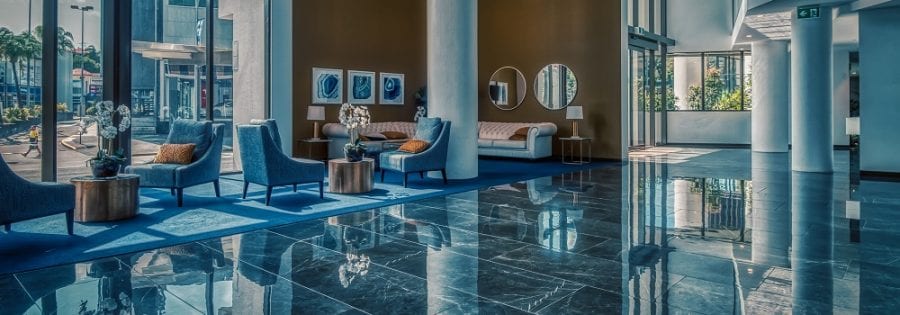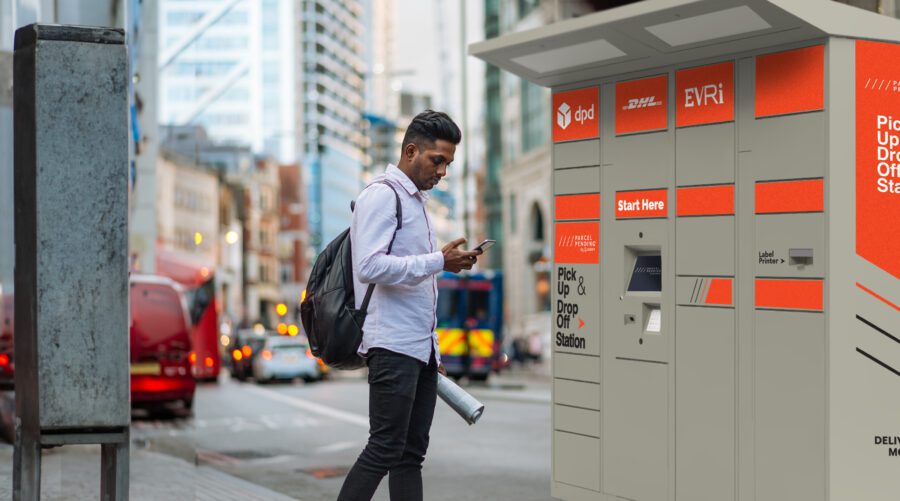
Multifamily
5 Lobby Amenities Every Multifamily Complex Needs
Written by: Parcel Pending
7 Min Read
Published: February 23, 2020
Updated: April 3, 2023
The lobby is often the first place a potential resident will see when they tour a multifamily property. When designed and furnished correctly, it’s a chance to make a strong first impression. And, as the saying goes, “you only get one opportunity to impress.”
No matter the size of the building or the budget, there are simple design concepts and apartment amenities that can be added to provide a welcoming entrance for both residents and visitors alike.
Below, we’ll discuss the most effective resident retention ideas and tell you what every multifamily community needs in order to bring in future residents and retain current residents.
5 Lobby Amenities Every Multifamily Community Needs
While resident rooms require uniformity and basic needs, lobbies provide an opportunity for creativity (both aesthetically and with the features integrated). It’s a chance to stand out and present the face, style, and feel of the complex. When done right, it can give the property curb appeal and make it stand out. Per the Cooperator:
Everyone in the building uses it, strangers have access, and building employees spend countless hours in it. It should look good, but not so good that you get sick of it quickly; it should fit the architectural style of the building, and convey nice things about the place, providing everyday pleasure and increasing the resale value of your unit.
Here are five lobby amenities that multifamily communities can implement to improve the current and prospective resident experience.
Make it a Group Effort
A lobby should be more than just a pretty greeting area. As Brick Underground writes, “while beautiful communal spaces are certainly not a bad thing for a building to have, don’t forget that you’re not designing the lobby purely for its aesthetic value: the area will get a lot of use, and should fit in with the building as a whole.”
If a full remodel is in the works, it may be worth talking to residents and seeing what they’d like in the floor space. Polling can help determine which features or designs appeal to the most people.
Questions worth asking include:
- What do you use the lobby for?
- What area or thing do you like most in the lobby?
- What is our lobby missing or lacking?
While a majority isn’t necessary, it helps to identify what people are interested in and it may result in money saved; otherwise, money may be spent on items that few residents would like or use.
Make it Safe and Secure
Time and again, resident polls dictate that their most important concern is safety. It’s a property manager’s job to ensure the safety of their residents and to do their best to prevent crime from occurring in or around the building. This starts with the main entrance.
If multifamily communities were a castle, the lobby is the main gate. It’s where the vast majority of both residents, guests, and workers will enter and exit. As a result, this is the largest security vulnerability, particularly if there’s no doorman or concierge. It’s crucial that this area is both locked and monitored since a resident’s sense of safety can be a major factor in both maximizing rent and minimizing vacancies and liabilities.
Ways this can be done include:
- Strong Locks – Most buildings have implemented a magnetic card or fob key system to secure their entryway.
- Virtual Concierge – If there’s neither room nor budget for an on-site concierge desk service, another option is outsourcing the work—property managers can hire an off-site employee to greet guests via high-definition video conferencing tech.
- Proper Lighting – If the goal is to make residents feel safe and at home, the lobby and the exterior entryway shouldn’t be dimly lit. Instead, fill the area with a warm and welcoming glow. Per Buildium:
Good lighting inside the lobby and directly outside the building will make anyone who’s entering or leaving feel much safer. It’s also a plus to have a system that will stay lit all the time, which becomes much more affordable as the cost of energy-efficient LED lighting has fallen dramatically. Additionally, install lighting on separate switches and with dimmers to vary lighting levels, for reasons of both safety and ambiance.
- Cameras – There should be security cameras recording 24/7 to ensure the safety of residents and to deter would-be criminals or thieves. Cameras should be placed at the front door, throughout the lobby, and in public-access
Fix the Package Problem
One issue that just about every single community is running into is a deluge of packages being sent to the building. Thanks to the rise of Amazon, more than half of Americans do their goods and grocery shopping online. This has resulted in a surge of packages being delivered daily.
In 2018, NMHC Kingsley conducted a package survey querying thousands of residents from various properties. They found some staggering figures:
- An average of 149 packages are delivered each week to the standard multifamily community.
- 61% of property managers say that package deliveries have increased year over year.
- For heavy/oversized packages, 52% of managers keep them in the management office, 32% deliver them to the resident’s door, and 22% store them in a separate storage area.
Unfortunately, few lobbies or mailrooms are equipped to handle this package influx, which all too often results in clutter, loss, or stolen packages. In addition, far too much of a property manager’s time is spent receiving, storing, and delivering packages.
Fortunately, there’s a better way to handle the problem. For those who want to learn how to prevent package theft, invest in smart lockers, such as those provided by Parcel Pending. These lockers are fantastic lobby amenities that are capable of providing the following:
- Security – Parcel Pending package lockers have 24/7 cameras that capture both deliveries and pickups.
- Intelligence – The lockers use infrared scanners to detect and categorize items in lockers. This means greater accuracy and accountability for property managers.
- Speed – Barcode technology makes it easy for packages to be delivered by any courier service.
- Intelligent Software – Parcel Pending’s software alerts residents when a package has been stored in the lockers and allows them to easily retrieve their items.
- Flexibility – The various compartments are capable of handling almost any size package. Refrigerated parcel lockers can also provide a property with temperature-controlled lockers for groceries, medicines, or perishables in general.
- Customizable Design – Parcel Pending lockers come in a variety of colors or with optional wraps so they can perfectly complement the lobby’s décor.
A solution to package woes is an amenity that’s going to be celebrated by the entire community — the property manager included.
Think of Hotels
The goal should be to make the lobby feel like that of a hotel. At hotels, the lobby is a unique common area that invites guests to socialize and relax. Although a multifamily property isn’t likely to have the same space as a 5-star hotel, it’s possible to take a similar idea, simplify it, and still create a special experience at the property.
Channeling this hotel aesthetic helps produce a classy atmosphere, making the property feel welcoming.
In fact, Hotelier Magazine writes:
It’s important that the lobby and the bar are places that don’t feel closed off from the rest of the city and don’t feel like they’re just for hotel guests or just to do your check-in and check-out or wait for your cab,” says Antonopoulos. “It’s an extension of the [guestroom] and of the city, so it’s important that lobbies and the bar are the kind of place that you want to go out to or spend time in.
Make it Communal
Lobbies are spaces that should be taken advantage of to their fullest. By making the space communal, millennial renters or their visitors are invited to mingle, relax, play, work, or converse.
Some smart apartment solutions can be implemented to achieve this, including:
- Plenty of Seating – While there may be limited space available, there should be both couches and chairs where residents can read, play a game, have a drink, or just relax.
- Large Screen TVs – Even though most residents have televisions, it can be nice to have TVs going in the lobby, particularly when big events are live, such as a sporting event, a press conference, or breaking news story. This can help foster a sense of community.
- Complimentary Drinks – Many modern communities have made the move to host nightly happy hours where residents are given complimentary drinks. It encourages people to come down, interact, and share a drink at the lobby bar. This multifamily marketing idea encourages both community and resident engagement.
- Working Areas – Some people require a change of scenery when they work or study. By having tables, working spaces, a meeting room or personal guest rooms, residents are given the opportunity to change up their work environment. Since many jobs are now done remotely, this is a great perk for any forward-thinking property.
- Computers And Printers – There should always be at least two computers and printers that residents can use if necessary. This convenience saves them from having to leave the property just to print something out. There should also be high-speed internet so guests can get whatever they need done in a timely manner.
Making Your Lobby Stand Out
Lobby design is an opportunity to make a great first impression or to welcome guests back to their home. Whether a property manager adds smart lockers or communal hotel amenities, putting the proper thought, time, and money into the lobby is a worthwhile investment that will please current residents and entice potential ones.
Sources:
- The Cooperator. A New Look for Your Lobby. https://cooperator.com/article/a-new-look-for-your-lobby/full
- Brick Underground. How to Renovate a Lobby and Keep (Almost) Everyone Happy. https://www.brickunderground.com/blog/2014/05/lobby_renovations_dos_and_donts
- Buildium. The Apartment Lobby: 5 Ways to Make it Welcoming and Safe. https://www.buildium.com/blog/apartment-building-lobby-design/
- NMHC. Package Primer. https://www.nmhc.org/globalassets/research–insight/package-survey-2018/nmhc_infographic.pdf
- Hotelier. Hotel Lobby Design is Key To Making a Good Impression. https://www.hoteliermagazine.com/hotel-lobby-design-key-making-good-impression/



